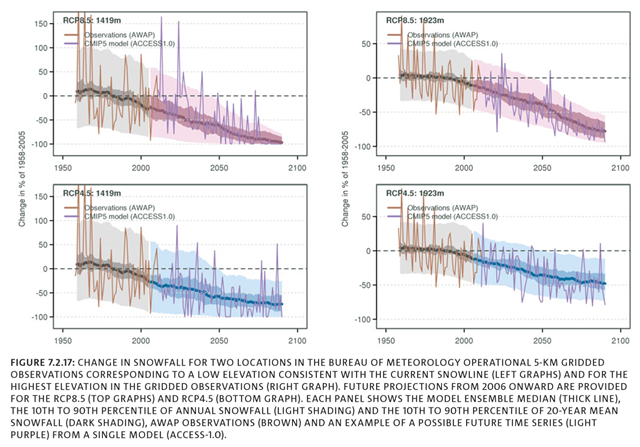Graph of the Day: Observed and projected snowfall decline in Australia, 1958-2090
27 January 2015 (CSIRO) – Snowfall in the Australian alps is projected to decrease, especially at low elevations. There is very high confidence that as warming progresses there will be a decrease in snowfall, an increase in snowmelt and thus reduced snow cover. These trends will be large compared to natural variability and most evident at low elevations. The spatial resolution of global climate models is too coarse to represent snow-covered areas in the Australian Alps directly. The highest elevation in CMIP5 models for grid boxes in South-Eastern Australia representative of the Australian Alps is between 290m and 940m (most models’ highest elevation is between 450m and 650m); hence no CMIP5 model can represent the snow covered Alpine area. Advanced offline snow models are required to explore projections of snow conditions across the Australian Alps. These methods provide projections of snow depth, area and duration, and integrate changes in snowfall, melt and ablation (Hennessy, et al., 2008, Hendrikx, et al., 2013). Such calculations using the latest climate models dataset (CMIP5) are not available yet. Projected changes in snowfall have been assessed using statistically downscaled CMIP5 climate model results. Accumulated precipitation falling on days where maximum temperature stays below 2 °C has been used to create an annual total of equivalent snowfall. This has been done using the Bureau of Meteorology analogue-based statistical downscaling approach applied to 22 of the CMIP5 models. The annual equivalent snowfall was computed for two locations: a 5 km grid box (148.40W, 35.95S, elevation 1419m) near Cabramurra (NSW) for which a long-term observed record of annual snow accumulation exists (Davis, 2013), and the highest 5 km grid box (148.40W, 36.15S, elevation 1923m). The two locations provide an insight into future changes in snowfall across a range of elevations spanning the area where snow is currently observed. At these two locations (Figure 7.2.17), simulated snowfall showed a decline in the last 50 years. This observed snowfall decline is a component of the decline in snow accumulation observed at the Cabramurra station (Davis, 2013). The reduction in simulated snowfall is primarily due to warming rather than a decline in precipitation, i.e. an increase in the ratio of rain to snow. Davis (2013) also points to warming as being the primary reason for the observed decline in Cabramurra snow depth. Projections clearly show a continuing reduction in snowfall during the 21st century. The magnitude of decrease depends on the altitude of the region and on the emission scenario (Figure 7.2.17). At the low elevation grid box (1419m), years without snowfall start to be observed from 2030 in some models. By 2090, these years become common with RCP8.5. Figure 7.2.17 displays the result from a single downscaled model (ACCESS 1.0) illustrating how this model depicts interannual variability. It highlights the fact that with RCP4.5, while years without snowfall will become possible, years with normal snowfall (by today’s standard) still occur at the end of the 21st century but less frequently. At the high elevation grid box (1923m), the reduction of snowfall is less in percentage terms, averaging about 50% by 2090 with RCP4.5 and 80% with RCP8.5. These projections concern only snowfall, excluding the additional impacts of climate change on snow-melt and ablation. Hence the full picture in terms of snow depth, area, and duration is not provided. Such advanced analysis was performed using temperature and precipitation projections from 18 CMIP3 climate models as input to the CSIRO snow model to estimate changes in snow conditions over Victoria for 20-year periods centred on 2020 and 2050, relative to a 20-year period centred on 1990 (Bhend, et al., 2012). Results were calculated for each climate model for three diff erent IPCC SRES greenhouse gas emissions scenarios: low (B1), medium (A1B) and high (A1FI).
Climate Change in Australia: Projections for Australia’s NRM Regions
